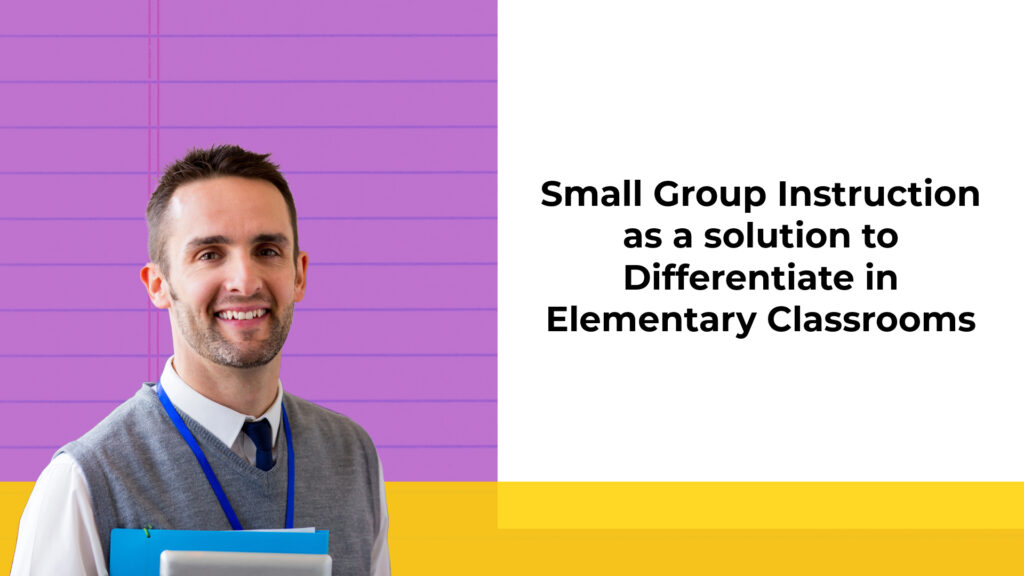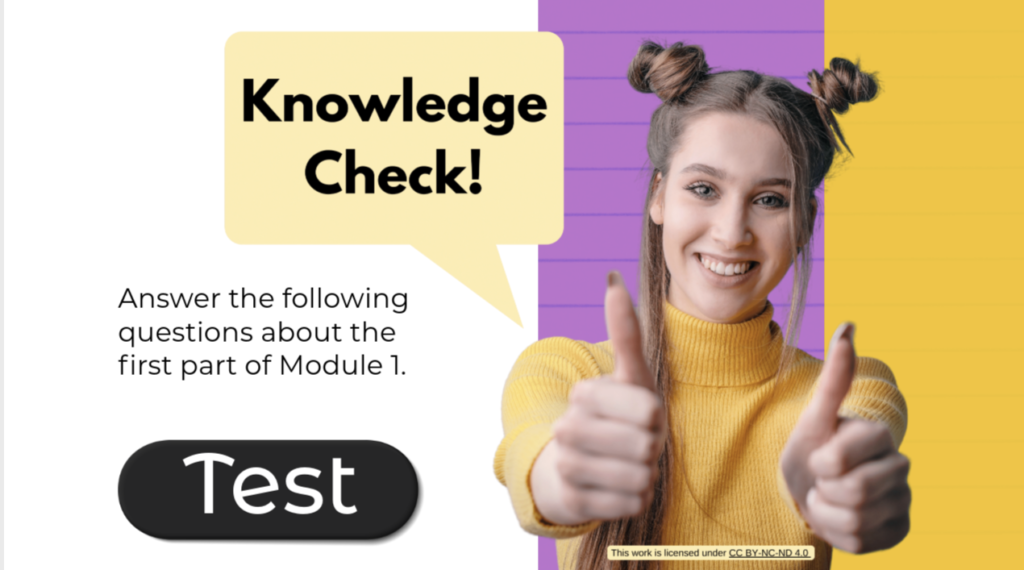Instructional Design Document
Small Group Instruction as a solution to differentiate in Elementary Classrooms
- Course Overview
- Knowledge Gap in Elementary Education
- Syllabus
- Target Audience and Learner profile
- Course Type
- Course Modality
- Course Learning Outcomes (CLOs)
- Module Learning Objectives (MLOs)
- Subject Matter Experts
- Learning Activities
- Instructional Design Model approach
- Learning Theories
- Digital Media
- Storyboards
- Course Evaluation
- Bibliography
Course Overview
In the last two years in Education K-12, we have seen how the gaps in Literacy and Math have been increasing due the interruption in Education during the pandemic.
Small group instruction has been proved to be an effective method to differentiate in a classroom, addressing individual needs and focus on the teaching of skills needed to decrease that gap.
During this course, the educators will gain the knowledge and skills required to apply the small group instruction efficiently in their classrooms. They will identify the benefits, the structure and the expectations of small groups at their school. In addition, they will recognize the main strategies and create their own. Finally, they will be able to create lesson plans and collaborate with all the stakeholders to succeed in this methodology of instruction.
You access the course here:

- Canvas: Log in here first!
- Email: pilargmunoz@hotmail.com
- Password: IDT400xstudent
- User name: GoshornIDT400xstudent
Knowledge Gap in Elementary Education

Key findings show that while learning did continue, progress toward academic recovery stalled in the 2022-2023 school year1. In addition to those academic gaps, we have seen how challenging behaviors increased, being more and more difficult to manage the whole group instruction in an Elementary Classroom.
Many elementary-aged students in the United States do not read age-appropriate material fluently. As such, small-group interventions are practical and often more time efficient than individualized interventions aimed to address this problem. 2
In a different research, results indicated generally higher gains for ELL students enrolled in direct instruction interventions.3 However, the educators need to be trained in how to differentiate the instruction based on needs using the small groups in the classroom.
To address the needs of children most at risk of reading failure, the same instructional components are relevant but they need to be made more explicit and comprehensive, more intensive, and more supportive in small-group or one-on-one formats4.
In this pilot program, the results showed how the staff development was essential to the success of each new initiative, and a significant amount of time was devoted to teacher training. Teachers were provided with training, modeling, coaching, and planning time to integrate the new ideas and skills into their lessons.5
Based on the data, this professional development training for educators and paraprofessionals will focus on small group instruction to address academic gaps in Literacy.
Syllabus
Check the mini-course syllabus for detailed information about schedule, grades and more.
If you prefer to read the Syllabus in Spanish, you can download it here:
Target Audience and Learner profile
The target audience of the mini-course will be the educators that are working in Elementary. It will be designed for one school district and it will be facilitated in each school, but it could also be extended to more school districts if the experience is successful.
The only pre-requisite will be to be already working in a classroom with Elementary students from Kinder to 5th grade. The strategies learned in this mini-course could be applied in K-5 classrooms.

The roles of the target audience are:
- Teachers: homeroom teachers and Specials teachers (Art, Music, STEM or PE).
- Paraprofessionals: any paraprofessional supporting instruction in classrooms K-5.
- Interventionists: Reading and Math specialists that pull out groups of students.
- Instructional coaches and Administration will also attend the mini-course since they are daily supporting and coaching educators in Elementary classrooms.
Having a background or experience in Education is desirable but not necessary. The academic language used in the course will be user friendly and several examples will be provided to support all learners. The paraprofessionals with no background in Education will be mentored by the homeroom teacher and Instructional Coach.
About the demographics, we have educators with ages between 20 and 60 years old with different background and learning styles. The mini-course will be implemented in a school district in Denver and a demographic survey will be included at the end to collect more information.
This is the demographics information for Denver school district during 2022-2023:
| Race | Female | Male | Total |
|---|---|---|---|
| American Indian or Alaska Native | 14 | 5 | 19 |
| Asian | 116 | 30 | 146 |
| Black or African American | 186 | 123 | 309 |
| Hispanic or Latino | 920 | 336 | 1256 |
| Native Hawaiian or Other Pacific Islander | 2 | 3 | 5 |
| Two or More Race | 112 | 36 | 148 |
| White | 3215 | 1168 | 4383 |
| Total teachers | 4565 | 1701 | 6266 |
The language used in the course will be English. However, knowing that we have multilingual educators who Spanish is their primary language, the syllabus will be translated to Spanish and the bilingual teachers and Instructional Coaches will also support.
The mini-course will be Accessible for all our learners and include the following supports:
- Closed-captions for the videos.
- Syllabus in English and Spanish with all the content included in the online course.
- Technology support available via email and phone.

Course Type
The mini-course will be a combination of a Step-by-Step course and a Problem-Solving course.
- The main goal of the mini-course is to provide information and strategies to implement small group instruction in the classroom. The modules will guide a step-by-step process to be successful in the small group instruction, from scheduling and grouping the students based on skills, to applying different strategies to collaborate.
- In addition, the mini-course is designed to offer a solution to a real scenario, so a Problem-Solving approach will allow the learners to solve different situations in their own classrooms.
Course Modality
This mini-course will have a Hybrid/Blended approach, combining both online and in-person elements for a balanced learning experience.
The mini-course will be asynchronous, allowing the self-pacing for the educators. However, real-time interaction is recommended to introduce each module for the whole school. Instructional coaches will introduce each module and then let the educators work at their own pace, setting deadlines to present the tasks and finalize the Knowledge ckecks.

The mini-course will be hosted in Canvas. This LMS is easy to navigate and educators can access to it from different devices. A guide to navigate (video) will be provided at the beginning of the course to support new learners with technology.
All participants will use their professional computers to access Canvas with their current user and password.
The mini-course will be launch for the whole school district, however it will be focused in each Elementary School for the in-person portion. Interactive discussion forums will be offered with all the participants in the school district to share opinions and post questions.
- The asynchronous portion will be completed during the planning time of the teachers. They can use the daily 40 minutes to complete each assignment. The asynchronous portion is intended to last no more than 60 minutes:
- Review the documentation: Less than 20 minutes.
- Complete the assignment: Less than 30 minutes.
- Complete the Knowledge Check: Less than 10 minutes.
- The in-person portion will be conducted by Instructional Coaches and/or Administration. They will briefly review the module correspondent to that week, materials and assignment. They will also give time to respond to questions and discuss the implementation in small groups. This portion is intended to last 30 minutes.
The mini-course is suggested to last seven weeks during the first semester of the school year. Instructional coaches will focus their observations and feedback on those objectives. The educators will have access to the content for the whole school year.
Feedback will be collected at the end of each module including a Knowledge check to measure if the learners are meeting the goals, and also a satisfaction survey at the end of the course to gather information about the user experience.
The leadership team will collect data from observations and feedback conversations to find trends and decide best supports for the small group implementation school wide. This would be a good way to have feedback about the mini-course and plan the necessary updates based on success and needs of the educators.
Course Learning Outcomes (CLOs)
Learning objectives of small groups by Pilar González- CLO1: Summarize the benefits of the small group instruction compared with the whole group instruction.
- CLO2: Divide the students in 4-5 small groups based on baseline assessments.
- CLO3: Collaborate to discuss data results and aligned instruction.
- CLO4: Design and facilitate lesson plans for small group instruction with a Content Language Objective.
- CLO5: Implement strategies to differentiate instruction based on the students’ needs.
- CLO6: Assess students’ progress by collecting data regularly.
Module Learning Objectives (MLOs)

- Module 1: Characteristics of small group instruction. After the completion of this module, the educators will be able to:
- Identify the purpose of small instruction answering correctly more than 80% in a Knowledge Check. (It aligns with CLO1)
- Compare the benefits of small and whole group instruction participating in a post discussion online and answering to 2 peers’ posts. (It aligns with CLO1)
- Describe the structure of a small group lesson creating a draft of a future lesson as an assignment. (It aligns with CLO4)
- Module 2: Expectations for small groups at your school. After the completion of this module, the educators will be able to:
- Identify when the small group instruction is in their schedule. (It aligns with CLO2)
- Use the baseline assessments data to create 4-5 groups of students in your classroom. (It aligns with CLO2 and CLO6)
- Identify professionals to collaborate and schedule meetings. (It aligns with CLO3)
- Design a system to collect data and track progress and share it to peer-review online. (It aligns with CLO6)
- Develop an explicit learning objective for each daily lesson during the first week and submit the assignment to review by your coach. (It aligns with CLO4)
- Select and prepare materials for the first weeks and share in an online post discussion. (It aligns with CLO4)
- Module 3: Strategies for small group instruction. After the completion of this module, the educators will be able to:
- Apply the Cooperative learning strategy sharing an example in the online discussion and adding at least 2 comments to peers’ responses. (It aligns with CLO5)
- Apply the Peer evaluation strategy sharing an example in the online discussion and adding at least 2 comments to peers’ responses. (It aligns with CLO5)
- Apply the Independent practice strategy sharing an example in the online discussion and adding at least 2 comments to peers’ responses. (It aligns with CLO5)
- Apply the Explicit strategies technique creating your own strategy cards. (It aligns with CLO5)
- Final Project: The educators will design 5 lessons for a small group of students, that include a content language objective, materials used, clear structure, at least one strategy per day and two different strategies per week and a system to collect the academic progress. The Instructional coach will observe, coach and evaluate the instruction of one of those lessons.
Subject Matter Experts
For the creation of the mini-course, there will be collaboration between instructional designers and SMEs. A small team of SMEs will be created with the purpose of design and review the learning course and update the necessary changes based on collected feedback from learners.

- Interventionists: They are experts in the small group instruction is a school, so they will support with strategies and content related to Literacy and Math.
- Instructional Leadership Team: Principals, Assistant Principals, Deans of Instructions and Instructional Coaches will also participate in the designing of the course.
- Curriculum Specialists from the School District: They will also be invited to be part of the SMEs team due to their experience and vision for the whole school district.
- Bibliography will also be consulted for the elaboration of the content.
Learning Activities
Due to the hybrid modality of the mini-course, the learning activities will provide support in different ways:
- Presentation in-person to introduce each module once a week. Instructional coaches or Administration will present the new content to clarify questions and present different examples valuable and personalized for the current school.
- Presentations online and asynchronous in Canvas. After the presentation in-person, the educators will have access to that module and follow the content at their own pace. After completion, interactive quizzes will measure the learning of the users.
- Collaborative Projects: The teachers will collaborate with Interventionists and Paraprofessionals to complete some of the real-world activities (review assessments and data, group students by skills, etc.). In these projects, peer-feedback will be encouraged as part of the methodology.
- Role-Playing: All educators will need to select their favorite strategies and practice before using them during the small group instruction. Educators will simulate challenging scenarios they might encounter in small group settings, followed by a debriefing session to discuss strategies and alternative approaches.
- Assignments: Each module will include one or more assignments to practice the content learned. Assignments can be reviewed and scored by Instructional Coaches or/and peers.
- Discussions and Debates: In Canvas, some activities will be assessed through discussions and debates. The educators will be encouraged to post their opinions and interact with other teachers, commenting at least two of their opinions.
Instructional Design Model approach
After considering and reviewing different learning models I chose the Understanding by Design (UdB) as the best approach for the Small Group Instruction mini-course.
- UbD starts from the end, creating the learning outcomes first. Considering that this mini-course was created to address a learning gap observed in our educators, this model is the best choice to ensure that the educators are gaining those skills.
- UdB is also a learner center model, so being the educators the target audience, they can adapt and apply the new learning into their real-world, their classrooms.

Other learning models offer interesting approaches that might be beneficial for the Small Groups mini-course. For example, the Rapid Instructional Design offers solutions to develop faster the learning experience using Authoring tools. In the mini-course, the Authoring tools used were:
- Canvas (LMS)
- Articulate Storyline (Module 3)
- Adobe Express, Canva, Loom, Voomly, etc.
Finally, the collaboration of all the stakeholders and the frequent updates based on feedback are keys in this mini-course, so applying Succesive Aproximation Model principles for small projects are also considered.
Learning Theories
The Learning Theories that will guide the whole mini-course will be Connectivism and Andragogy. These main theories will effectively drive the mini-course considering the audience and the content.
Here are the strengths and limitations of both theories for the mini-course:
Learning Theories Analysis by Pilar GonzálezConsidering the limitations, the Instructional Designer will focus in provide the following solutions:
- A previous how-to guide will be provided to the educators to teach them how to navigate in the online platform.
- The educators will follow the school district policy regarding Security and Privacy data if they share information in Social Media.
- The mini-course will be included in the planning time of the educators in their schedule during school hours to reduce the extra work and commitment requirement.
- The mini-course will include different opportunities to interact with the materials, collaborate with educators in and out of the school and personalize the outcome and adapt it to their own needs. These strategies will increase engagement and motivation.
If you want to know more about the Learning Theories and ID Models that I follow to create this course, please visit this page!
Digital Media
In this section, I will include the resources included to support the content of the Mini-course. All of them will be evaluated using the Checklist created by the Instructional Designer.
You can have access to the Checklist template here:
Video with Instructions about how to navigate in Canvas and structure of the Course
It is important to include a brief video with instructions regarding the LMS selected, in this case Canvas, and the different structure of the course. Check the following video to know more:
Video for Module 1
This is the video presentation created to introduce the Module 1. You can read more about this resource here.
And here you can see the evaluation of one article related to the content of the current mini-course:
Digital Image for the Knowledge Checks

I created a Digital Image to introduce the Knowledge Checks. You can know more about this resource here. I incorporate the new image in the last video using Adobe Express. You can see the result here.
This is the Checklist complete to evaluate the Digital Image.
Screencast Video for Module 3
You can read about the process and the software tools used here.
Checklist to evaluate the video above:
Animation Video for Module 2
You can read about the process and the software tools used here.
Interactive Module 3 using Articulate Storyline
You can read about the process and Authoring tool used here.
For an assignment, I incorporated different interactive digital audios from a testimony from an experienced teacher using the Peer-Evaluation technique in Module 3. You can read about the process here.
Storyboards
Storyboard is a powerful tool for the Instructional Designer to get a first approach to the Design phase. It is a helpful step to translate ideas into realistic slides or videos for a learning experience. I can check errors in the flow of the learning experience, and make the necessary adjustments before continue with the designing and development process.
They are first prototype to share with the rest of the stakeholders such as Subject Matter Experts, Graphic Designers, Project Managers, etc.
These are the original storyboards created for the minicourse.
Course Evaluation
In the following link you can read more about the evaluation rubric and outcomes of after a deep reflection. Here is the rubric used and tou can read the strenghts and areas to improve at the end of the document.
Bibliography
- Lewis, Karyn, and Megan Kuhfeld. “Education’s Long COVID: 2022-23 Achievement Data Reveal Stalled Progress toward Pandemic Recovery.” Center for School and Student Progress at NWEA (2023). ↩︎
- Begeny, John C., et al. “Increasing elementary-aged students’ reading fluency with small-group interventions: A comparison of repeated reading, listening passage preview, and listening only strategies.” Journal of Behavioral Education 18 (2009): 211-228. ↩︎
- Kamps, D., Abbott, M., Greenwood, C., Arreaga-Mayer, C., Wills, H., Longstaff, J., Culpepper, M., & Walton, C. (2007). Use of Evidence-Based, Small-Group Reading Instruction for English Language Learners in Elementary Grades: Secondary-Tier Intervention. Learning Disability Quarterly, 30(3), 153-168. https://doi.org/10.2307/30035561 ↩︎
- Foorman, Barbara R., and Joseph Torgesen. “Critical elements of classroom and small‐group instruction promote reading success in all children.” Learning Disabilities Research & Practice 16.4 (2001): 203-212. ↩︎
- Beecher, M., & Sweeny, S. M. (2008). Closing the Achievement Gap With Curriculum Enrichment and Differentiation: One School’s Story. Journal of Advanced Academics, 19(3), 502-530. https://doi.org/10.4219/jaa-2008-815 ↩︎